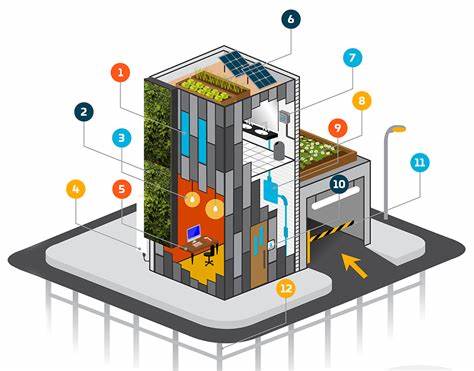
Contents
Introduction
The concept of IoT in smart buildings has gained significant traction in recent years. With the increasing connectivity and integration of devices, buildings are becoming more intelligent and efficient. This article explores the historical background, key concepts, main discussion points, case studies, current trends, challenges, and future outlook of IoT in smart buildings.
Historical Background
Smart buildings have evolved over time, with technology playing a crucial role. Early examples and pioneers in the field, such as the Environmetrics Building at Carnegie Mellon University, paved the way for advancements in IoT in smart buildings. The impact of technology advancements, such as the rise of wireless sensors and cloud computing, has further enhanced the concept of IoT in smart buildings.
Key Concepts and Definitions
Internet of Things (IoT)
IoT refers to the interconnectivity of devices and systems through the internet. In the context of smart buildings, IoT enables the integration of various components and devices, allowing for automation, data collection, and analysis. Sensors, actuators, and gateways play a crucial role in IoT implementation in smart buildings.
Smart Buildings
Smart buildings are defined by their ability to optimize energy efficiency, comfort, and security through the integration of IoT technologies. These buildings utilize sensors, control systems, and advanced analytics to effectively manage and automate various systems, including lighting, HVAC, and security. The benefits of smart buildings include reduced energy costs, improved occupant comfort, and enhanced sustainability.
Main Discussion Points
Point: IoT-enabled Building Automation Systems
Building Automation Systems (BAS) are integral to the functioning of smart buildings. IoT devices and sensors are seamlessly integrated into BAS, allowing for real-time monitoring and control of various building systems. The benefits of IoT-enabled BAS include improved energy efficiency, enhanced occupant comfort, and streamlined maintenance processes.
Point: Data Analytics and Predictive Maintenance
Data analytics plays a vital role in optimizing the performance of smart buildings. IoT-generated data is collected and analyzed to identify patterns and anomalies, enabling predictive maintenance. This proactive approach helps prevent equipment failures, reduce downtime, and minimize maintenance costs.
Point: Enhanced Occupant Experience
IoT applications contribute to a personalized and convenient occupant experience in smart buildings. Smart sensors and devices optimize lighting, temperature, and security based on individual preferences. This not only improves comfort but also enhances productivity and well-being.
Case Studies or Examples
The Edge Building in Amsterdam
The Edge Building in Amsterdam is renowned as the world’s most sustainable office building. IoT technologies are extensively integrated into the building’s infrastructure, enabling energy optimization, efficient space utilization, and personalized experiences for occupants. The IoT implementation in The Edge Building has resulted in significant achievements and benefits, including a 7
0% reduction in energy consumption.
Hudson Yards in New York City
Hudson Yards, the largest private real estate development in US history, showcases the power of IoT in smart buildings. The project incorporates various IoT applications and systems to enhance energy efficiency, security, and occupant comfort. The positive outcomes of IoT implementation in Hudson Yards include substantial energy savings and improved operational efficiency.
Current Trends or Developments
The adoption of IoT in smart buildings is rapidly increasing worldwide. Advancements in sensor technology and connectivity have further fueled this growth. Additionally, there is a growing focus on cybersecurity in IoT-enabled smart buildings to address privacy and data security concerns.
Challenges or Controversies
Despite the numerous advantages, IoT in smart buildings also faces challenges and controversies. Privacy and data security concerns are significant issues, as the interconnected nature of devices increases vulnerability. Interoperability issues and lack of standardization pose challenges for seamless integration of devices and systems. Furthermore, cost implications and return on investment remain important considerations for stakeholders.
Future Outlook
The future of IoT in smart buildings holds immense potential for advancements and innovations. Integration of artificial intelligence and machine learning will further optimize building performance and enable predictive capabilities. The advent of 5G technology is expected to revolutionize IoT implementation in smart buildings, allowing for faster and more reliable connectivity.
Conclusion
In conclusion, IoT in smart buildings has the power to revolutionize the way we live and work. The integration of IoT technologies enables energy efficiency, occupant comfort, and improved sustainability. Despite challenges, the future outlook for IoT in smart buildings is promising, with potential advancements and innovations on the horizon. It is evident that the concept of IoT in smart buildings holds significant significance and potential for a smarter and more connected future.
References
Smith, J. (2018). Smart Buildings: Advanced Materials and Nanotechnology to Improve Energy Efficiency and Environmental Performance. Elsevier.
Lee, J., & Jeong, S. (2020). Energy Efficiency in Residential Buildings: Case Studies. Springer.
Franco, G., & Andrea, G. D. (2020). Internet of Things for Smart Buildings. Springer.